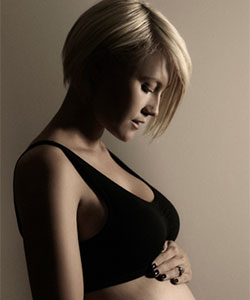5 Tips for Dealing with Post-Pregnancy Hair Loss
Having a new baby is a joyful time but it is also one of the most stressful times in a woman’s life. In addition to sleepless nights, body changes, and caring for a new baby, many women also find themselves dealing with a completely unexpected, surprising, and worrisome condition known as Telogen Effluvium, the medical name for postpartum or post-pregnancy hair loss. According to AmericanPregnancy.org, this condition affects as many as half of all pregnant women.

You are NOT Alone
During pregnancy, hair growth is stimulated by an increase in estrogen in the woman’s body. This is why many pregnant women find their hair is thicker, stronger, and longer during the course of their pregnancy. However, a greater volume of hair during pregnancy also means that there are a greater number of hairs that also enter the resting phase during and after pregnancy.
Hairs in the resting phase, which accounts for approximately ten percent of all hair, do just as the name implies – they rest, and then within a few months, they fall out in order to allow the growth of new hair. Higher estrogen levels during pregnancy inhibit this cycle; as pregnancy ends, the estrogen levels in the woman’s body begin returning to a normal level and the hair follicles also return to a normal cycle of growth and resting. When this happens, typically within the first few months postpartum, women can experience an increased – and sometimes alarming – loss of hair.
Here Yomna from Egypt sharing her experience
Thankfully, as estrogen levels return to normal and new hair begins growing, most women see hair growth returning; many find that by their baby’s first birthday their hair has regrown. While it is reassuring to know that lost hair will regrow, there are several ways women can minimize the change in their hair’s appearance due to postpartum hair loss.
Haircut Choices
If a large hair loss leaves hair looking thinner, try a layered cut or a shorter cut to help add volume and movement to your hair. Or follow some of the tips offered for fine hair.
Avoid Stress to the Hair Follicles
While it is tempting to simply pull your hair back into a ponytail or bun to keep it off of your face and to hide any hair loss, the stress of the tension on your hair and hair follicles could actually cause even more fall out. Try allowing hair to hang loose and free instead.
Use a Gentle Touch
Try using hair products with simpler, more natural ingredients that will be gentler on your hair. While it is tempting to want to improve your hair’s appearance through adding highlights or coloring or other processes, try waiting several months before undergoing any styling to your hair that involves the use of harsh chemicals.
Take Vitamins and Eat Well
While you may no longer need a prenatal vitamin, taking a good daily vitamin supplement for women may help your hair have the nutrients it needs as it begins to regrow. Be sure to eat foods that help with hair growth, balanced diet with fruits, vegetables, whole grains, and protein as well.
Most cases of postpartum hair loss resolve naturally over the course of time. If it does not, make an appointment with a physician to discuss if there are any other underlying conditions that may be causing your hair loss.

